会计学原理 19版 怀尔德 复习提纲 Chapter 1~4
会计学原理知识点提纲汇总
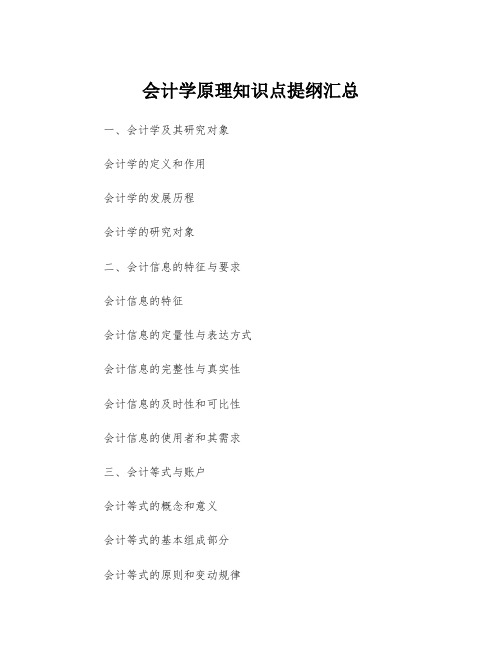
会计学原理知识点提纲汇总一、会计学及其研究对象会计学的定义和作用会计学的发展历程会计学的研究对象二、会计信息的特征与要求会计信息的特征会计信息的定量性与表达方式会计信息的完整性与真实性会计信息的及时性和可比性会计信息的使用者和其需求三、会计等式与账户会计等式的概念和意义会计等式的基本组成部分会计等式的原则和变动规律账户的概念和作用账户的分类和特点四、会计账簿与记录方法会计账簿的种类和作用会计账簿的编制原则会计记录方法的基本要求会计记录方法的种类和特点五、会计核算的基本过程会计核算的目的和方法会计核算的基本过程会计核算的基准和周期六、会计要素和会计科目会计要素的概念和种类会计要素的核算依据会计科目的概念和分类会计科目的表现方式和特点七、会计凭证和会计账会计凭证的概念和作用会计凭证的种类和使用方法会计凭证的记载要求和审核程序会计账的概念和作用会计账的种类和编制方法八、会计分录与会计报表会计分录的概念和要素会计分录的编制方法和处理规则会计报表的概念和分类会计报表的编制要求和内容九、会计确认和会计估计会计确认的意义和条件会计确认的对象和方法会计估计的概念和作用会计估计的方法和原则十、会计准则和会计政策会计准则的概念和作用会计准则的分类和特点会计政策的概念和作用会计政策的确定和变更十一、会计监管与会计伦理会计监管的意义和目的会计监管的主体和方式会计伦理的概念和要求会计伦理的核心价值和规范结论以上是关于会计学原理的知识点提纲的汇总。
通过学习会计学原理,我们能够了解会计学的定义、发展历程以及研究对象。
同时,我们还能了解会计信息的特征与要求,会计等式与账户的概念和作用,会计账簿与记录方法的种类和特点等重要内容。
进一步学习会计核算的基本过程、会计要素和会计科目的概念与表现方式,以及会计凭证和会计账的使用方法和编制要求。
此外,还需了解会计分录与会计报表的编制方法和处理规则,以及会计确认和会计估计的意义、方法和条件。
《会计学原理》复习提纲

《会计学原理》复习提纲《会计学原理》复习提纲第一章总论1.会计是怎样产生和发展的?在会计的发展史上,有哪几座里程碑?其标志性事件是什么?2.※会计的基本职能有哪两个?它们分别有哪些特点?二者的关系是什么?3. ※什么是会计?会计的本质、特点是什么?※4.会计的一般对象是什么?社会总资金及其运动方式是什么?5.什么是会计的具体对象?※工业企业的具体会计对象是什么?※以图文并茂的方式描述工业企业的资金运动。
6. ※会计核算的基本前提有哪四个?理解其含义和作用。
7.什么是会计确认基础?※什么是权责发生制、收付实现制?※它们的适用范围分别是什么?8. ※会计的计量属性有哪些?理解它们的含义?9. ※会计信息的质量要求有哪些?理解它们的含义?※10.会计核算方法有哪七种?为什么说它们是一个完整的方法体系?11.什么是会计学?会计学包括那些学科?各学科的主要内容是什么?第二章会计科目与账户12.什么是会计要素?※我国的会计要素有哪六个?掌握各会计25. ※什么是会计分录?什么是简单分录、复合分录?会计分录的书写格式是什么?※26.什么是总账、明细账?总账和明细账有什么联系和区别?※27.什么是平行登记?详述平行登记的要点。
第四章账户与复式记账法的应用(上)28.工业企业的主要经济业务包括哪些内容?29.资金筹集主要有哪些业务?涉及哪些账户?如何进行账务处理?30.生产准备业务主要有哪些内容?涉及哪些账户?如何进行账务处理?31.什么是固定资产?如何确定固定资产的原始价值?32.什么是无形资产?如何确定无形资产的入账价值?无形资产的研发支出应该分别计入哪些账户?33.什么是商业汇票?※商业汇票按照承兑人不同可以分为哪两类?第五章账户与复式记账法的应用(下)34.产品生产业务包括哪些内容?涉及哪些账户?如何进行账务处理?35.产品销售业务主要有哪些内容?涉及哪些账户?如何进行账务处理?36.什么是利润?利润的计算公式有哪几个?37.利润形成的核算涉及哪些账户?如何进行账务处理?※38.什么是利润分配?利润分配的基本程序是什么?39.利润分配的核算涉及哪些账户?如何进行账务处理?第六章账户分类40.什么是账户的经济内容?账户按经济内容可以分为哪几类?分别包括那些账户?※41.什么是账户的用途和结构?账户按用途和结构可以分为哪几类?各包括那些主要账户?※42.简述盘存账户的概念、特点、结构以及包括的具体账户。
会计学原理-复习大纲
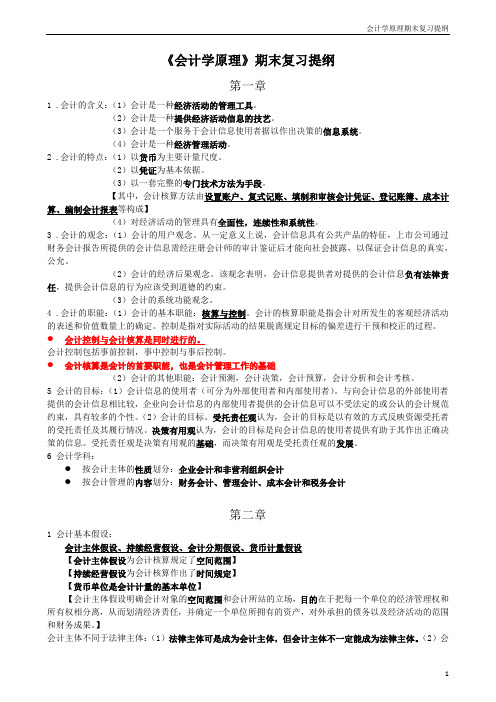
《会计学原理》期末复习提纲第一章1 .会计的含义:(1)会计是一种经济活动的管理工具。
(2)会计是一种提供经济活动信息的技艺。
(3)会计是一个服务于会计信息使用者据以作出决策的信息系统。
(4)会计是一种经济管理活动。
2 .会计的特点:(1)以货币为主要计量尺度。
(2)以凭证为基本依据。
(3)以一套完整的专门技术方法为手段。
【其中,会计核算方法由设置账户、复式记账、填制和审核会计凭证、登记账簿、成本计算、编制会计报表等构成】(4)对经济活动的管理具有全面性,连续性和系统性。
3 .会计的观念:(1)会计的用户观念。
从一定意义上说,会计信息具有公共产品的特征,上市公司通过财务会计报告所提供的会计信息需经注册会计师的审计鉴证后才能向社会披露,以保证会计信息的真实,公允。
(2)会计的经济后果观念。
该观念表明,会计信息提供者对提供的会计信息负有法律责任,提供会计信息的行为应该受到道德的约束。
(3)会计的系统功能观念。
4 .会计的职能:(1)会计的基本职能:核算与控制。
会计的核算职能是指会计对所发生的客观经济活动的表述和价值数量上的确定。
控制是指对实际活动的结果脱离规定目标的偏差进行干预和校正的过程。
●会计控制与会计核算是同时进行的。
会计控制包括事前控制,事中控制与事后控制。
●会计核算是会计的首要职能,也是会计管理工作的基础(2)会计的其他职能:会计预测,会计决策,会计预算,会计分析和会计考核。
5 会计的目标:(1)会计信息的使用者(可分为外部使用者和内部使用者)。
与向会计信息的外部使用者提供的会计信息相比较,企业向会计信息的内部使用者提供的会计信息可以不受法定的或公认的会计规范约束,具有较多的个性。
(2)会计的目标。
受托责任观认为,会计的目标是以有效的方式反映资源受托者的受托责任及其履行情况。
决策有用观认为,会计的目标是向会计信息的使用者提供有助于其作出正确决策的信息。
受托责任观是决策有用观的基础,而决策有用观是受托责任观的发展。
19版会计学原理怀尔德答案Chapter 1
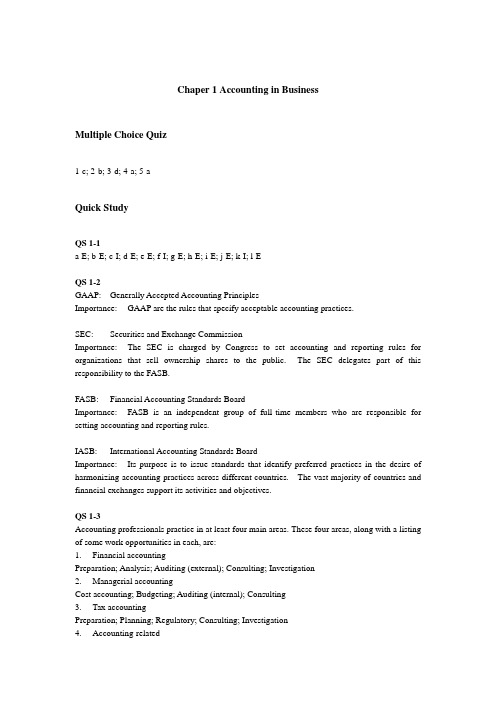
Chaper 1 Accounting in BusinessMultiple Choice Quiz1-c; 2-b; 3-d; 4-a; 5-aQuick StudyQS 1-1a-E; b-E; c-I; d-E; e-E; f-I; g-E; h-E; i-E; j-E; k-I; l-EQS 1-2GAAP: Generally Accepted Accounting PrinciplesImportance: GAAP are the rules that specify acceptable accounting practices.SEC: Securities and Exchange CommissionImportance: The SEC is charged by Congress to set accounting and reporting rules for organizations that sell ownership shares to the public. The SEC delegates part of this responsibility to the FASB.FASB: Financial Accounting Standards BoardImportance: FASB is an independent group of full-time members who are responsible for setting accounting and reporting rules.IASB: International Accounting Standards BoardImportance: Its purpose is to issue standards that identify preferred practices in the desire of harmonizing accounting practices across different countries. The vast majority of countries and financial exchanges support its activities and objectives.QS 1-3Accounting professionals practice in at least four main areas. These four areas, along with a listing of some work opportunities in each, are:1. Financial accountingPreparation; Analysis; Auditing (external); Consulting; Investigation2. Managerial accountingCost accounting; Budgeting; Auditing (internal); Consulting3. Tax accountingPreparation; Planning; Regulatory; Consulting; Investigation4. Accounting-relatedLending; Consulting; Analyst; Investigator; AppraiserQS 1-4Internal controls serve several purposes:They involve monitoring an organization’s activities to promote efficiency and to prevent wrongful use of its resources.They help ensure the validity and credibility of accounting reports.They are crucial for effective operations and reliable reporting.More generally, the absence of internal controls can adversely affect the effectiveness of domestic and global financial markets.QS 1-5a. Revenue recognition principleb. Cost principle (also called historical cost)c. Business entity principleQS 1-6The choice of an accounting method when more than one alternative method is acceptable often has ethical implications. This is because accounting information can have major impacts on individuals’ (and firms’) well-being.To illustrate, many companies base compensation of managers on the amount of reported income. When the choice of an accounting method affects the amount of reported income, the amount of compensation is also affected. Similarly, if workers in a division receive bonuses based on the d ivision’s income, its computation has direct financial implications for these individuals.QS 1-7a=125,000b=250,000c=125,000QS 1-8QS 1-9(a) Examples of business transactions that are measurable include:Selling products and services.Collecting funds from dues, taxes, contributions, or investments.Borrowing money.Purchasing products and services.(b) E xamples of business events that are measurable include:Decreases in the value of securities (assets).Bankruptcy of a customer owing money.Technological advances rendering patents (or other assets) worthless.An “act of God” (casualty) that destroys assets.QS 1-10a-B; b-I; c-B; d-CF; e-I; f-B; g-B; h-CF; i-OEExcisesExcise 1-1External users and some questions they seek to answer with accounting information include:1. Shareholders (investors), who seek answers to questions such as:a. Are resources owned by a business adequate to carry out plans?b. Are the debts owed excessive in amount?c. What is the current level of income (and its components)?2. Creditors, who seek answers for questions such as:a. Does the business have the ability to repay its debts?b. Can the business take on additional debt?c. Are resources sufficient to cover current amounts owed?3. Employees, who seek answers to questions such as:a. Is the business financially stable?b. Can the business afford to pay higher salaries?c. What are growth prospects for the organization?Excise 1-21. C 5. B2. C 6. A3. A 7. B4. A 8. BExcise 1-3a. Auditing professionals with competing audit clients are likely to learn valuable information about each client that the other clients would benefit from knowing. In this situation the auditor must take care to maintain the confidential nature of information about each client.b. Accounting professionals who prepare tax returns can face situations where clients wish to claim deductions they cannot substantiate. Also, clients sometimes exert pressure to use methods not allowed or questionable under the law. Issues of confidentiality also arise when these professionals have access to clients’ personal records.c. Managers face several situations demanding ethical decision making in their dealings with employees. Examples include fairness in performance evaluations, salary adjustments, and promotion recommendations. They can also include avoiding any perceived or real harassment of employees by the manager or any other employees. It can also include issues of confidentiality regarding personal information known to managers.d. Situations involving ethical decision making in coursework include performing independentwork on examinations and individually completing assignments/projects. It can also extend to promptly returning reference materials so others can enjoy them, and to properly preparing for class to efficiently use the time and question period to not detract from others’ instructional benefits.Excise 1-41-E; 2-G; 3-A; 4-C; 5-D; 6-B; 7-F; 8-HExcise 1-5a-S; b-C; c-S; d-C; e-C; f-P; g-SExcise 1-6a=180,000b=51,000c=139,000Excise 1-71-D; 2-G; 3-B; 4-F; 5-AExcise 1-8a-27,000b-221,607c. beginning balance is 73,000; ending balance is 149,000Excise 1-9a. Business purchases equipment (or some other asset) on credit.b. Business signs a note payable to extend the due date on an account payable.c. Business pays an account payable (or some other liability) with cash (or some other asset).d. Business purchases office supplies (or some other asset) for cash (or some other asset).e. Business incurs an expense that is not yet paid (for example, when employees earn wages that are not yet paid).f. Owner invests cash (or some other asset) in the business; OR, the business earns revenue and accepts cash (or another asset).g. Cash withdrawals (or some other asset) paid to the owner of the business; OR, the business incurs an expense paid in cash.Exercise 1-10Real AnswersIncome StatementFor Month Ended October 31Exercise 1-11Real AnswersStatement of Owner ’s Equity Exercise 1-12Real Answers Balance Sheet October 31AssetsCash $ 11 500 Account receivable 12 000 Office supplies 24 437 Land 46 000 Office equipment 18 000 Total assets $ 111 937LiabilitiesAccount payables $ 25 037 Total liabilities 25 037Owner ’s EquityKeisha King, Capital 86 900 Total liabilities and equity $ 111 937Exercise 1-13Real Answers Cash Flow Statement For Month Ended October 31Excise 1-141-O; 2-O; 3-F; 4-O; 5-O; 6-O; 7-F; 8-IProblem 1-1AProblem 1-2Aa. Cash 67,000Equipment 11,000I. Lopez, Capital 78,000Owner’s investmentb. Building 144,000Cash 15,000Notes Payable 129,000 Purchased building on cash and note payable c. Equipment 12,000Cash 12,000Purchased equipment on cashd. Supplies 1,000Equipment 1,700Account Payable 2,700Purchased supplies and equipment on credite. Advertising Expense 460Cash 460Paid announcement of opening on newspaper f. Account Receivable 2,400Revenue 2,400To record revenue for service provided on account g. Cash 4,000Revenue 4,000Received revenue on cashh. I. Lopez, Withdrawals 3,025Cash 3,025Cash withdrawal by owneri. Cash 1,800Account Receivables 1,800Partially received account receivablej. Account Payables 500Cash 500Partially paid account payablesk. Wages Expense 1,800Cash 1,800Paid wages of secretary’s。
会计学原理知识点提纲
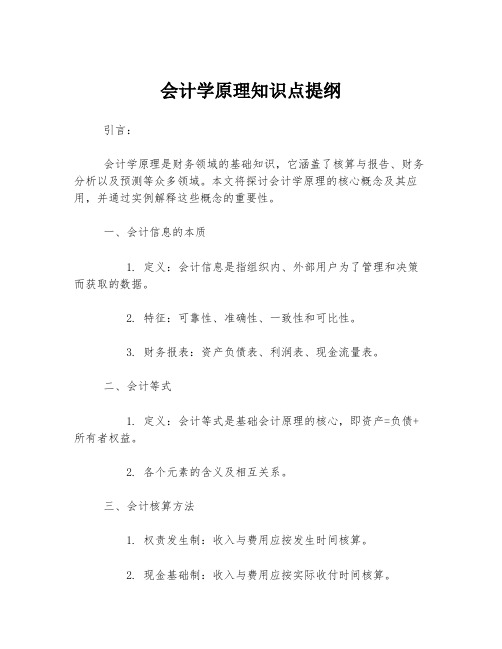
会计学原理知识点提纲引言:会计学原理是财务领域的基础知识,它涵盖了核算与报告、财务分析以及预测等众多领域。
本文将探讨会计学原理的核心概念及其应用,并通过实例解释这些概念的重要性。
一、会计信息的本质1. 定义:会计信息是指组织内、外部用户为了管理和决策而获取的数据。
2. 特征:可靠性、准确性、一致性和可比性。
3. 财务报表:资产负债表、利润表、现金流量表。
二、会计等式1. 定义:会计等式是基础会计原理的核心,即资产=负债+所有者权益。
2. 各个元素的含义及相互关系。
三、会计核算方法1. 权责发生制:收入与费用应按发生时间核算。
2. 现金基础制:收入与费用应按实际收付时间核算。
3. 选择核算方法的依据。
四、会计估计与错报1. 定义:会计估计是在不完全信息下对未来发生事件的处理。
2. 估计的方法及应用场景。
3. 错误的原因及对企业的影响。
五、会计准则与法规1. 国际会计准则、中国会计准则以及国际财务报告准则。
2. 规范会计信息披露的目的及重要性。
3. 企业应如何遵守准则与法规。
六、财务报表分析1. 比率分析:盈利能力、偿债能力、运营能力等指标的计算与分析。
2. 垂直与水平分析方法的应用。
3. 财务报表分析的局限性及注意事项。
七、会计原则中的特殊问题1. 结构计算:长期资产摊销、无形资产摊销等。
2. 提前收入与递延收入。
3. 不确定债务的计量。
结语:会计学原理是进行财务管理与决策的基础知识。
通过理解会计信息的本质、会计等式与核算方法、会计估计与错报、会计准则与法规、财务报表分析以及会计原则中的特殊问题,企业可以更好地运用会计原理从而提高企业的财务管理能力与决策能力。
因此,深入掌握会计学原理的概念和应用显得尤为重要。
会计学原理-2019
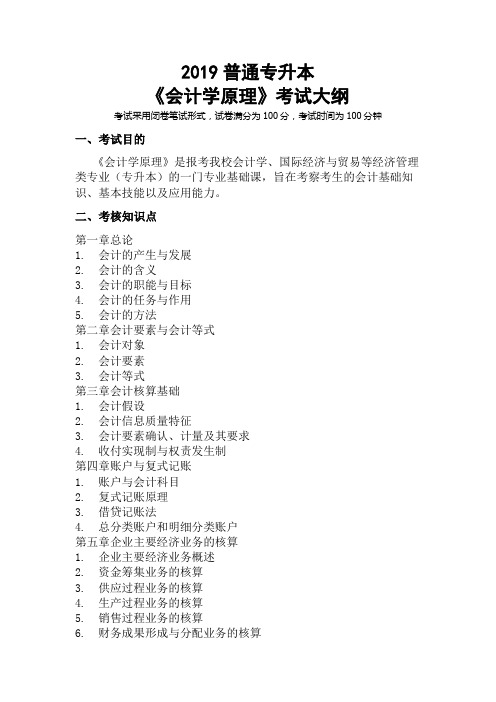
2019普通专升本《会计学原理》考试大纲考试采用闭卷笔试形式,试卷满分为100分,考试时间为100分钟一、考试目的《会计学原理》是报考我校会计学、国际经济与贸易等经济管理类专业(专升本)的一门专业基础课,旨在考察考生的会计基础知识、基本技能以及应用能力。
二、考核知识点第一章总论1. 会计的产生与发展2. 会计的含义3. 会计的职能与目标4. 会计的任务与作用5. 会计的方法第二章会计要素与会计等式1. 会计对象2. 会计要素3. 会计等式第三章会计核算基础1. 会计假设2. 会计信息质量特征3. 会计要素确认、计量及其要求4. 收付实现制与权责发生制第四章账户与复式记账1. 账户与会计科目2. 复式记账原理3. 借贷记账法4. 总分类账户和明细分类账户第五章企业主要经济业务的核算1. 企业主要经济业务概述2. 资金筹集业务的核算3. 供应过程业务的核算4. 生产过程业务的核算5. 销售过程业务的核算6. 财务成果形成与分配业务的核算第六章账户的分类1. 账户分类的意义2. 账户按经济内容分类3. 账户按用途和结构分类第七章成本计算1. 成本计算的意义、原理与要求2. 成本计算的一般程序3. 企业经营过程中的成本计算第八章会计凭证1. 会计凭证的作用和种类2. 原始凭证3. 记账凭证4. 会计凭证的传递与保管第九章会计账簿1. 账簿的意义与种类2. 账簿的设置与登记3. 账簿的启用与错账更正4. 结账与对账5. 账簿的更换与保管第十章财产清查1. 财产清查概述2. 存货的盘存制度3. 财产清查的内容和方法4. 财产清查结果的处理第十一章财务报告1. 财务报告概述2. 资产负债表3. 利润表4. 现金流量表5. 所有者权益(或股东权益)变动表6. 会计报表附注第十二章会计核算组织程序1. 会计核算组织程序概述2. 记账凭证核算组织程序3. 科目汇总表核算组织程序4. 汇总记账凭证核算组织程序5. 日记总账核算组织程序三、参考书目陈国辉,迟旭升主编,《基础会计》,东北财经大学出版社,2018年7月第六版四、考试题型考试题型有:名词解释、选择题、判断题、简答题、计算题、会计分录题等。
怀尔德会计学原理答案chapter1
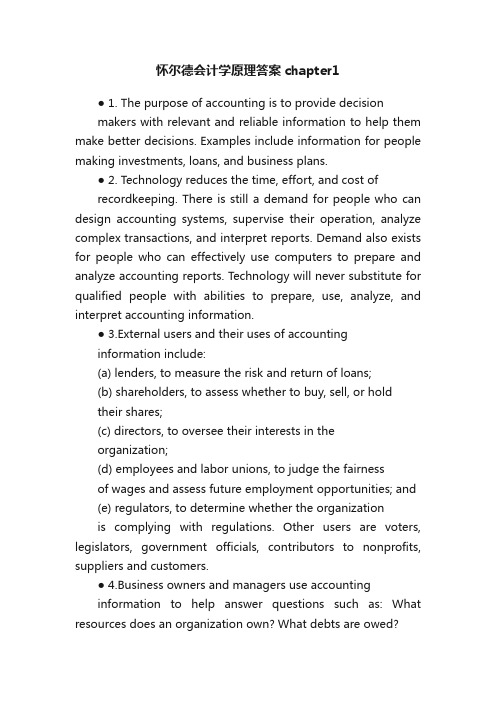
怀尔德会计学原理答案chapter1● 1. The purpose of accounting is to provide decisionmakers with relevant and reliable information to help them make better decisions. Examples include information for people making investments, loans, and business plans.● 2. Technology reduces the time, effort, and cost ofrecordkeeping. There is still a demand for people who can design accounting systems, supervise their operation, analyze complex transactions, and interpret reports. Demand also exists for people who can effectively use computers to prepare and analyze accounting reports. Technology will never substitute for qualified people with abilities to prepare, use, analyze, and interpret accounting information.● 3.External users and their uses of accountinginformation include:(a) lenders, to measure the risk and return of loans;(b) shareholders, to assess whether to buy, sell, or holdtheir shares;(c) directors, to oversee their interests in theorganization;(d) employees and labor unions, to judge the fairnessof wages and assess future employment opportunities; and(e) regulators, to determine whether the organizationis complying with regulations. Other users are voters, legislators, government officials, contributors to nonprofits, suppliers and customers.● 4.Business owners and managers use accountinginformation to help answer questions such as: What resources does an organization own? What debts are owed?How much income is earned? Are expenses reasonable for the l evel of sales? Are customers‘ accounts being promptly collected?● 5. Service businesses include: Standard and Poor‘s, Dun& Bradstreet, Merrill Lynch, Southwest Airlines, CitiCorp, Humana, Charles Schwab, and Prudential.Businesses offering products include Nike, Reebok, Gap, Apple Computer, Ford Motor Co., Philip Morris, Coca-Cola, Best Buy, and Circuit City.● 6. The internal role of accounting is to serve theorganization‘s internal operating functions. It does this by providing useful information for internal users in completing their tasks more effectively and efficiently. By providing this information, accountinghelps the organization reach its overall goals.●7.Accounting professionals offer many servicesincluding auditing, management advice, tax planning, business valuation, and money management.●8.Marketing managers are likely interested ininformation such as sales volume, advertising costs, promotion costs, salaries of sales personnel, and sales commissions.●9. Accounting is described as a service activity because it serves decision makers by providing information to help them make better business decisions.●10. Some accounting-related professions include consultant,financial analyst, underwriter, financial planner, apprai ser, FBI investigator, market researcher, and system desig ner.●11. Ethics rules require that auditors avoid auditing clientsin which they have a direct investment, or if the audit or‘s fee is dependent on the figures in the client‘s rep orts. This will prevent others from doubting the quality of the auditor‘s report.●12. In addition to preparing tax returns, tax accountantshelp companies and individuals plan future transactions to minimize the amount of tax to be paid. They are also acti vely involved in estate planning and in helping set up org anizations. Some tax accountants work for regulatory agenc ies such as theIRS or the various state departments of rev enue. These tax accountants help to enforce tax laws.●13.The objectivity concept means t hat financial statementinformation is supported by independent, unbiased evidence other than someone‘s opinion or imagination. This concept increases the reliability and verifiability of financia l statement information.●14. This treatment is justified by both the cost principleand the going-concernassumption.●15. The revenue recognition principle provides guidance for managers and auditors so they know when to recognize rev enue. If revenue is recognized too early, the business loo ks more profitable than it is. On the other hand, if reven ue is recognized too late the business looks less profitab le than it is. This principle demands that revenue be reco gnized when it is both earned and can be measured reliably.The amount of revenue should equal the value of the asset s received or expe cted to be received from the business‘s operating activities covering a specific time period.●16. Business organizations can be organized in one of three basic forms: sole proprietorship, partnership, or corporation. These forms have implications for legal liability, taxation, continuity, number of owners, and legal status a s follows:见课本第8页那张表(即exhibit 1.8)●17. (a) Assets are resources owned or controlled by a company that are expected toyield future benefits.(b) Li abilities are creditors‘ claims on assets that reflect obligations to provide assets, products or services to others.(c) Equity is the owner‘s claim on assets and is equalto assets minus liabilities.(d) Net assets refer to equity.●18. Equity is increased by investments from the owner andby net income. It is decreased by withdrawals by the owner and by a net loss (which is the excess of expenses over re venues).●19. Accounting principles consist of (a) general and (b) specific principles. General principles are the basic assum ptions,concepts, and guidelines for preparing financial st atements. They stem from long-used accounting practices. S pecific principles are detailed rules used in reporting on business transactions and events. They usually arise from the rulings of authoritative and regulatory groups such a s the Financial Accounting Standards Board or the Securiti es and Exchange Commission.●20. Revenue (or sales) is the amount received from sellingproducts and services.●21. Net income (also called income, profit or earnings) equals revenues minus expenses (if revenues exceed expenses).Net income increases equity. If expenses exceed revenues, the company has a Net Loss. Net loss decreases equity.●22. The four basic financia l statements are: income statement,statement of owner‘s equity, balance sheet, and state ment of cash flows.●23.An income statement reports a company‘s revenues andexpenses along with the resulting net income or loss overa period of time.●24. Rent expense, utilities expense, administrative expenses,advertising and promotion expenses, maintenance expense, andsalaries and wages expenses are some examples of busin ess expenses.●25.The statement of owner‘s equity explains the changesin equity from net income or loss, and from any owner cont ributions and withdrawals over a period of time.●26.The balance sheet describes a company‘s financial position (types and amounts of assets, liabilities, and equit y) at apoint in time.●27. The statement of cash flows reports on the cash inflows and outflows from a company‘s operating, investing, and financing activities.。
会计学原理讲义第一至四章

《会计学原理》讲义第一章会计概说第一节会计概说正如我们所能观察到的,无论是营利性质的企业,还是非营利性质的事业、行政机关、非盈利性质的社会团体等单位,均设有“会计”工作岗位,配有会计人员。
只要有经济活动的地方,不论是组织还是个人经营,都在开展着从简单到复杂的会计核算活动。
与此相适应,不管是高等教育,还是中等专业教育,甚至是职业教育,都设有会计专业,共同为社会培训和输送着不同层次的会计专业人才。
“会计”作为一种工作,在现代经济管理中正发挥着举足轻重的作用;在现有的学科群体中,“会计”作为一门科学,也正备受关注;而作为一项职业,毋庸说,“会计”职业显然是经济社会活动中不可缺少的一个行当,会计的职业道德以“诚信”为准则,会计信息以真实、及时为基本要求,会计人员及其所开展的会计活动因此得到社会的信赖和尊重。
这一切都说明:社会非常需要会计,社会非常重视会计。
一、会计行为探源会计是人类为追求经济效益而进行的一种管理经济的活动。
人类要生存,离不开物质资料的生产和消费。
生产物质资料的目的,在于向人类社会提供所需要的生产资料和生活资料,生产过程同时也是消费过程,所以,生产活动是最基本的实践活动,是人类赖以生存和发展的基础。
在生产过程中,人们通过使用劳动工具,耗用劳动资料,投入劳动量,花费劳动时问,生产出劳动产品,必然十分关心自己的劳动成果,会自觉地将生产过程的内容记录下来,盘算、比较其生产耗费(所费)和生产成果(所得)的数量损益。
如果生产所得不足以抵补生产所费(称为亏损),这种生产纯粹在消耗社会财富,或者说是对社会财富的浪费,毫无经济效益可言,应立即停止;如果生产所得在抵补生产所费后还有结余(称为盈利),则生产有了经济效益。
结余部分如仅够供给生活消费,则只能按原有规模重复进行简单再生产,社会不能发展;结余部分如在满足生活消费后还有多余作为追加生产投资,则可按更大的规模进行扩大再生产,社会由此向前发展。
可见,社会发展的程度取决于所能扩大的规模即生产过程经济效益的好坏。
会计学原理复习提纲
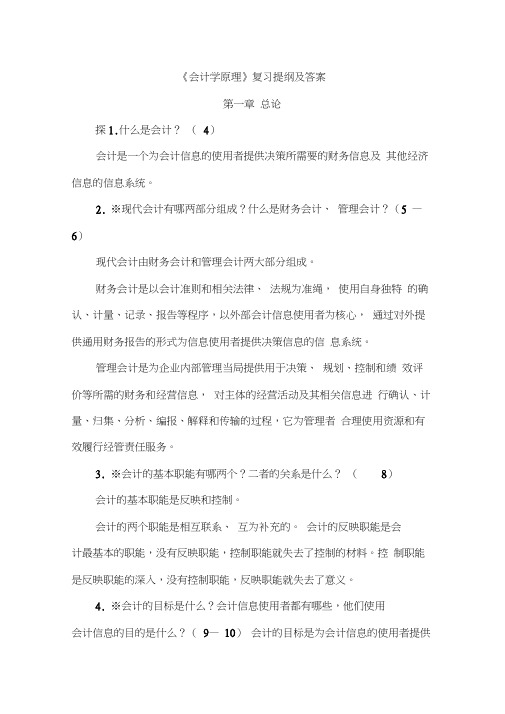
《会计学原理》复习提纲及答案第一章总论探1.什么是会计?(4)会计是一个为会计信息的使用者提供决策所需要的财务信息及其他经济信息的信息系统。
2.※现代会计有哪两部分组成?什么是财务会计、管理会计?(5 —6)现代会计由财务会计和管理会计两大部分组成。
财务会计是以会计准则和相关法律、法规为准绳,使用自身独特的确认、计量、记录、报告等程序,以外部会计信息使用者为核心,通过对外提供通用财务报告的形式为信息使用者提供决策信息的信息系统。
管理会计是为企业内部管理当局提供用于决策、规划、控制和绩效评价等所需的财务和经营信息,对主体的经营活动及其相关信息进行确认、计量、归集、分析、编报、解释和传输的过程,它为管理者合理使用资源和有效履行经管责任服务。
3.※会计的基本职能有哪两个?二者的关系是什么?(8)会计的基本职能是反映和控制。
会计的两个职能是相互联系、互为补充的。
会计的反映职能是会计最基本的职能,没有反映职能,控制职能就失去了控制的材料。
控制职能是反映职能的深入,没有控制职能,反映职能就失去了意义。
4.※会计的目标是什么?会计信息使用者都有哪些,他们使用会计信息的目的是什么?(9—10)会计的目标是为会计信息的使用者提供决策所需的财务信息及其相关经济信息。
会计信息使用者有投资者、债权人、社会公众、财政和税务等政府机构、证券交易所、财务分析机构和往来客户、企业管理当局、内部职工等。
投资者需要会计信息来帮助他们决定是否应该买进、卖出或继续持有投资及对一个主体支付股利的能力的能力进行评估;债权人需要会计信息来评估经济主体所欠他们的款项能否如期支付;企业管理当局需要了解自己履行对经济资源的受托经管责任的状况;政府及其机构关心资源的分配;雇员及其工会组织需要会计信息来评估一个主体提供给雇员报酬、退休福利和就业机会的能力;顾客需要评估一个主体的延续能力;社会公众关心一个主体的发展能力、发展趋势、环境治理投入、资源消耗状况等方面的信息。
《会计学原理》复习资料(第四章)全全全!!
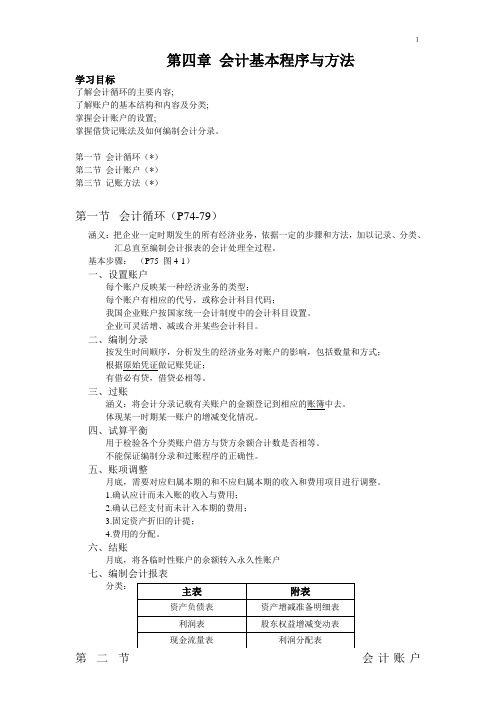
1第四章会计基本程序与方法学习目标了解会计循环的主要内容;了解账户的基本结构和内容及分类;掌握会计账户的设置;掌握借贷记账法及如何编制会计分录。
第一节会计循环(*)第二节会计账户(*)第三节记账方法(*)第一节会计循环(P74-79)涵义:把企业一定时期发生的所有经济业务,依据一定的步骤和方法,加以记录、分类、汇总直至编制会计报表的会计处理全过程。
基本步骤:(P75 图4-1)一、设置账户每个账户反映某一种经济业务的类型;每个账户有相应的代号,或称会计科目代码;我国企业账户按国家统一会计制度中的会计科目设置。
企业可灵活增、减或合并某些会计科目。
二、编制分录按发生时间顺序,分析发生的经济业务对账户的影响,包括数量和方式;根据原始凭证做记账凭证;有借必有贷,借贷必相等。
三、过账涵义:将会计分录记载有关账户的金额登记到相应的账簿中去。
体现某一时期某一账户的增减变化情况。
四、试算平衡用于检验各个分类账户借方与贷方余额合计数是否相等。
不能保证编制分录和过账程序的正确性。
五、账项调整月底,需要对应归属本期的和不应归属本期的收入和费用项目进行调整。
1.确认应计而未入账的收入与费用;2.确认已经支付而未计入本期的费用;3.固定资产折旧的计提;4.费用的分配。
六、结账月底,将各临时性账户的余额转入永久性账户七、编制会计报表分类:主表附表资产负债表资产增减准备明细表利润表股东权益增减变动表现金流量表利润分配表2第二节会计账户(P79-92)一、会计账户的设置(*)二、账户的名称(*)三、账户的基本结构(*)四、账户的分类(*)一、会计账户的设置(P79-80)账户的涵义:指对会计要素的具体内容所作的科学分类。
内容:账户的名称,即会计科目。
账户的用途与结构。
账户与会计科目的区别和联系(*):联系:会计科目与账户都是对会计对象具体内容的科学分类,两者口径一致,性质相同。
会计科目是账户的名称,也是设置账户的依据;账户是根据会计科目开设的,是会计科目的具体运用。
会计学原理复习大纲

会计学原理复习大纲会计学原理是一门系统地研究企业会计基本理论、基本方法和基本制度的学科。
下面是会计学原理复习大纲,主要包括会计的基本概念、会计的基本假设、会计的基本分类、会计主体和会计要素、会计的基本过程和会计的基本制度等内容。
一、会计的基本概念1.会计的含义和作用:会计是一种经济管理活动,以核算为主要内容,以提供信息为目的,以决策为导向。
2.会计的基本特征:客观性、真实性、时效性、可比性等。
二、会计的基本假设1.会计实体假设:将企业看作一个独立经济单位进行核算。
2.实体和业务活动的连续性假设:企业的业务活动是连续进行的,所以需要按照时间周期进行核算。
3.货币计量假设:以货币为计量基准进行会计核算。
4.会计期间假设:将企业的业务活动划分为若干个会计期间进行核算。
三、会计的基本分类1.财务会计和管理会计:财务会计以外部利益相关方为对象,主要目的是提供企业整体经济活动的真实、准确的信息。
管理会计以内部管理者为对象,主要目的是为企业管理层提供决策支持。
2.静态会计和动态会计:静态会计主要关注其中一时刻的企业财务状况,如财务报表。
动态会计主要关注企业在一段时间内的经济活动,如成本会计、预算会计等。
四、会计主体和会计要素1.会计主体:被核算的经济单位,包括个体经济组织和自然人。
2.会计要素:反映企业经济活动的成本、价值和盈余的基本组成部分,包括资产、负债、所有者权益、收入和费用。
五、会计的基本过程1.记账:根据会计凭证将经济业务转化为会计账务记录。
2.调试:对会计账务记录进行校对、调整和汇总。
3.编制财务报表:根据会计凭证和会计账务记录编制资产负债表、损益表等财务报表。
4.分析和解读财务报表:对财务报表进行分析,评价企业的经营状况和盈利能力。
六、会计的基本制度1.会计职业道德:会计师应遵循的道德规范和职业准则。
2.会计制度:包括会计制度的建立、完善和实施,以及会计制度的规范和监督。
3.会计信息系统:包括会计信息的采集、处理和传输等环节,以及会计信息系统的设计和管理。
会计学原理复习提纲

会计学原理复习提纲一、会计的定义和职能会计是以货币为主要计量单位,运用专门的方法,对企业、机关单位或其他经济组织的经济活动进行连续、系统、全面地反映和监督的一项经济管理活动。
会计具有两大基本职能,分别是核算和监督。
核算职能是指会计以货币为主要计量单位,对特定主体的经济活动进行确认、计量、记录和报告,为有关各方提供会计信息。
监督职能则是指会计对特定主体经济活动和相关会计核算的真实性、合法性和合理性进行审查。
二、会计基本假设和会计基础(一)会计基本假设1、会计主体:明确会计核算的空间范围,是指企业会计确认、计量和报告的空间范围。
2、持续经营:假定企业在可预见的未来会按照当前的规模和状态继续经营下去,不会停业,也不会大规模削减业务。
3、会计分期:将企业持续经营的生产经营活动划分为一个个连续的、长短相同的期间。
4、货币计量:会计主体在会计确认、计量和报告时以货币计量,反映会计主体的生产经营活动。
(二)会计基础1、权责发生制:企业会计的确认、计量和报告应当以权责发生制为基础。
权责发生制要求,凡是当期已经实现的收入和已经发生或应当负担的费用,无论款项是否收付,都应当作为当期的收入和费用;凡是不属于当期的收入和费用,即使款项已在当期收付,也不应当作为当期的收入和费用。
2、收付实现制:则是以款项的实际收付为标准来确认本期收入和费用。
三、会计要素及其确认与计量(一)会计要素会计要素是对会计对象进行的基本分类,包括资产、负债、所有者权益、收入、费用和利润。
1、资产:是指企业过去的交易或者事项形成的、由企业拥有或者控制的、预期会给企业带来经济利益的资源。
2、负债:是指企业过去的交易或者事项形成的、预期会导致经济利益流出企业的现时义务。
3、所有者权益:是指企业资产扣除负债后,由所有者享有的剩余权益。
4、收入:是指企业在日常活动中形成的、会导致所有者权益增加的、与所有者投入资本无关的经济利益的总流入。
5、费用:是指企业在日常活动中发生的、会导致所有者权益减少的、与向所有者分配利润无关的经济利益的总流出。
《会计学原理》复习提纲
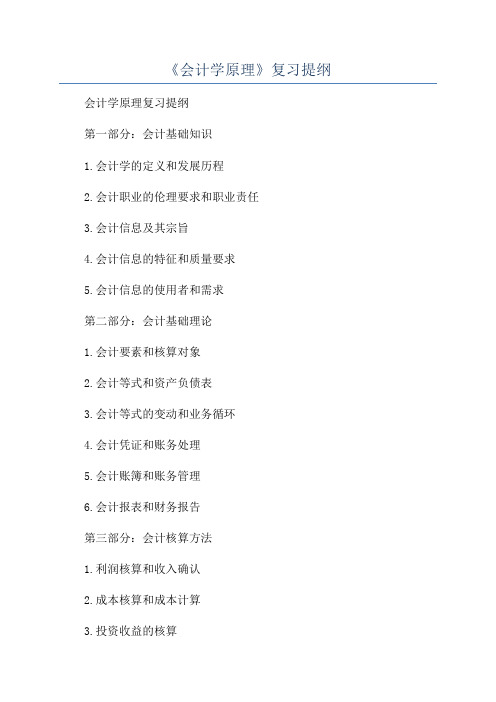
《会计学原理》复习提纲会计学原理复习提纲第一部分:会计基础知识1.会计学的定义和发展历程2.会计职业的伦理要求和职业责任3.会计信息及其宗旨4.会计信息的特征和质量要求5.会计信息的使用者和需求第二部分:会计基础理论1.会计要素和核算对象2.会计等式和资产负债表3.会计等式的变动和业务循环4.会计凭证和账务处理5.会计账簿和账务管理6.会计报表和财务报告第三部分:会计核算方法1.利润核算和收入确认2.成本核算和成本计算3.投资收益的核算4.现金与应收账款的核算5.应付账款和其他应付款的核算6.存货和固定资产的核算第四部分:会计信息分析与决策1.资产负债表分析2.利润表分析3.现金流量表分析4.财务比率分析5.基本财务风险评估6.会计信息在决策中的应用第五部分:会计制度和法律法规1.会计制度的基本框架和内容2.会计核算准则和会计政策3.中国会计制度和国际会计准则4.会计法律法规和会计监管第六部分:会计信息系统1.会计信息系统的概念和组成部分2.会计信息系统的设计和实施3.会计信息系统的运行和维护4.信息技术对会计信息系统的影响5.会计信息安全和风险管理第七部分:会计伦理和职业发展1.会计职业伦理和职业行为准则2.会计职业道德和职业责任3.会计职业的发展和未来趋势4.会计师的职业角色和责任5.会计师执业和培训要求总结:会计学原理的核心概念和基本知识-会计学定义、发展历程和会计职业的伦理要求-会计信息特征、宗旨和质量要求,使用者及其需求-会计要素、核算对象和会计等式的变动过程-会计凭证、账务处理、账簿管理和财务报告-会计核算方法和会计信息分析与决策-会计制度与法律法规、会计信息系统和会计伦理-会计职业发展和会计师的职业角色和责任注意:-针对每个部分进行重点复习,掌握核心概念和要点-将理论知识与实际案例结合,加强理解和应用能力-多做习题和案例分析,检验自己的掌握程度-注意会计法律法规和会计政策的最新动态,及时更新知识-关注会计职业发展和会计伦理,提高个人职业素养总结提纲只是为了方便复习的参考,希望能对你的复习有所帮助。
怀尔德《会计学原理》19版答案 (2)
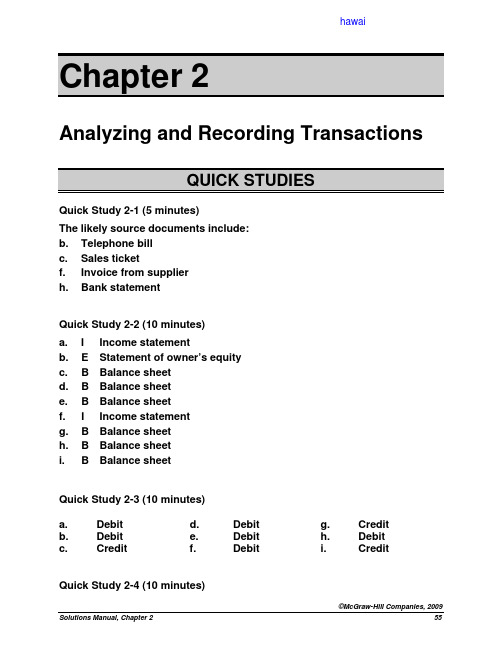
hawai Chapter 2Analyzing and Recording TransactionsQUICK STUDIESQ uick Study 2-1 (5 minutes)The likely source documents include:b. Telephone billc. Sales ticketf. Invoice from supplierh. Bank statementQ uick Study 2-2 (10 minutes)a. I Income statementb. E Statement of owner’s equityc. B Balance sheetd. B Balance sheete. B Balance sheetstatementf. I Incomeg. B Balance sheeth. B Balance sheeti. B BalancesheetQuick Study 2-3 (10 minutes)a. Debit d. Debit g. Creditb. Debit e. Debit h. Debitc. Credit f. Debit i. Credit Quick Study 2-4 (10 minutes)©McGraw-Hill Companies, 2009 Solutions Manual, Chapter 2 55a. Debit e. Debit i. Creditb. Debit f. Credit j. Debitc. Credit g. Credit k. Debitd. Credit h. Debit l. CreditQ uick Study 2-5 (10 minutes)a. Debit e. Debit i. Creditb. Credit f. Credit j. Debitc. Debit g. Creditd. Credit h. CreditQ uick Study 2-6 (15 minutes)Jan.13 Cash.......................................................................... 80,000Equipment...............................................................30,000Capital...............................................110,000 D.Tyler,Owner invests cash and equipment.21Supplies (820)OfficePayable (820)AccountsPurchased office supplies on credit.29Cash..........................................................................8,700Revenue....................8,700 LandscapingServicesReceived cash for landscaping services.30Cash..........................................................................4,000Services Revenue..4,000UnearnedLandscapingReceived cash in advance for landscaping services.Q uick Study 2-7 (10 minutes)The correct answer is c.Explanation: If a $2,250 debit to Rent Expense is incorrectly posted as a credit, the effect is to understate the Rent Expense debit balance by $4,500.This causes the Debit column total on the trial balance to be $4,500 lessthan the Credit column total.Q uick Study 2-8 (10 minutes)a. I e. B i. Bb. I f. I j. I©McG56c. I g. B k. Ed. B h. B l. B©McGraw-Hill Companies, 2009 Solutions Manual, Chapter 2 57EXERCISESE xercise 2-1 (15 minutes) Type of Increase Normal Account Account (Dr. or Cr.) Balancea. Owner Capital.............................equity credit creditb. Accounts Receivable.................asset debit debitc. Owner Withdrawals....................equity debit debitd. Cash............................................asset debit debite. Equipment..................................asset debit debitf. Fees Earned................................revenue credit creditg. Wages Expense..........................expense debit debith. Unearned Revenue....................liability credit crediti. Accounts Payable......................liability credit creditj. Postage Expense.......................expense debit debitk. Prepaid Insurance......................asset debit debitl. Land............................................asset debit debitE xercise 2-2 (15 minutes) a. Beginning cash balance (debit).............................................$ ?Cash received in October (debits)........................................104,750Cash disbursed in October (credits).....................................(101,607)Ending cash balance (debit)..................................................$ 17,069Beginning cash balance (debit).............................................$ 13,926b. Beginning accounts receivable (debit).................................$ 83,250Sales on account in October (debits)................................... ?Collections on account in October (credits)........................(75,924)Ending accounts receivable (debit)......................................$ 85,830Sales on account in October (debits)...................................$ 78,504c. Beginning accounts payable (credit)....................................$148,000Purchases on account in October (credits).........................271,876Payments on accounts in October (debits).......................... ( ?)Ending accounts payable (credit).........................................$137,492Payments on accounts in October (debits)..........................$282,384 ©McG58The company would make the following entry (not required for answer): Cash..................................................................12,000Equipment......................................90,000 ComputerNote Payable..............................................37,000Services Revenue......................................65,000 Accepted cash, equipment and note for services.Thus, of the a through f items listed, the following effects should be included:a. $37,000 increase in a liability account.b. $12,000 increase in the Cash account.e. $65,000 increase in a revenue account.Explanation: This transaction reflects $65,000 in revenue, which is the value of the service provided. Payment is received in the form of a $12,000 increase in cash, an $90,000 increase in computer equipment, and a $37,000 increase in its liabilities. The net value received by the company is $65,000.Exercise 2-4 (25 minutes)Aug.1Cash.................................................................. 14,250Photography Equipment.................................61,275M. Harris, Capital.......................................75,525Owner investment in business.2Prepaid Insurance............................................3,300Cash............................................................3,300Acquired 24 months of insurance coverage.5Office Supplies.................................................2,707Cash............................................................2,707Purchased office supplies.20Cash.................................................................. 3,250Photography Fees Earned........................3,250Collected photography fees.31 Utilities Expense (871)Cash (871)Paid for August utilities.©McGraw-Hill Companies, 2009 Solutions Manual, Chapter 2 59Cash Photography EquipmentAug. 1 14,250 Aug. 23,300Aug. 1 61,27520 3,250 52,70731871M. Harris, CapitalBalance 10,622 Aug. 1 75,525 Office Supplies Photography Fees Earned3,25020 Aug.52,707 Aug.Prepaid Insurance Utilities ExpenseAug.87131Aug.23,300SPECIAL PICSTrial BalanceAugust 31Debit Credit Cash...............................................................................$10,622Office supplies..............................................................2,707Prepaid insurance.........................................................3,300 Photography equipment...............................................61,275M. Harris, Capital...........................................................$75,525 Photography fees earned.............................................3,250 Utilities expense............................................................ 871_______ Totals..............................................................................$78,775 $78,775©McGraw-Hill Companies, 2009Fundamental Accounting Principles, 19th Edition 60Cash Accounts Payable(a) 14,000 (b) 406(e) 7,742 (c) 7,7427,742Balance(e)(d) 1,652510(h) 1,246(g)1,200(i)Balance 7,040 S. Amena, Capital(a) 14,00014,000Balance Accounts Receivable S. Amena, Withdrawals(f) 2,968 (h) 1,246(i) 1,200Balance 1,722 Balance 1,200Office Supplies Fees Earned1,652 (b) 406 (d) Balance 406 (f) 2,968Balance4,620 Office Equipment Rent Expense(c) 7,742 (g) 510Balance 7,742 Balance 510Exercise 2-7 (15 minutes)AMENA COMPANYTrial BalanceMay 31, 2009Debit Credit Cash.........................................................................................$ 7,040Accounts receivable...............................................................1,722Office supplies (406)Office equipment....................................................................7,742Accounts payable...................................................................$ 0S. Amena, Capital...................................................................14,000S. Amena, Withdrawals..........................................................1,200Fees earned.............................................................................4,620 Rent expense.......................................................................... 510______ Totals.......................................................................................$18,620 $18,620©McGraw-Hill Companies, 2009 Solutions Manual, Chapter 2 61Transactions that created expenses:b. Salaries Expense.........................................1,233Cash.......................................................1,233 Paid salary of receptionist.d. Utilities Expense (870)Cash (870)Paid utilities for the office.[Note: Expenses are outflows or using up of assets (or the creation ofliabilities) that occur in the process of providing goods or services tocustomers.]Transactions a, c, and e are not expenses for the following reasons:a. This transaction decreased assets in settlement of a previouslyexisting liability, and equity did not change. Cash payment does notmean the same as using up of assets (expense was recorded when thesupplies were used).c. This transaction involves the purchase of an asset. The form of thecompany’s assets changed, but total assets did not change, and theequity did not decrease.e. This transaction is a distribution of cash to the owner. Even thoughequity decreased, the decrease did not occur in the process ofproviding goods or services to customers.©McG62TECH TALKIncome StatementFor Month Ended October 31RevenuesConsulting fees earned......................... $25,620 ExpensesSalariesexpense................................... $12,405expense......................................... 6,859Rentexpense (560)TelephoneMiscellaneousexpenses (280)expenses...................................... 20,104 TotalNet income.................................................. $ 5,516Exercise 2-10 (15 minutes)TECH TALKStatement of Owner’s EquityFor Month Ended October 31D. Shabazz, Capital, October 1.................. $ 0Add: Investments by owner.................... 124,114income5,516 Net(from Exercise 2-10)......129,630 Less: Withdrawals by owner.................... 2,000D. Shabazz, Capital, October 31................ $127,630Exercise 2-11 (15 minutes)TECH TALKBalance SheetOctober 31Assets Liabilities Cash...............................$ 12,614 Accounts payable................$ 12,070 Accounts receivable.... 25,648Office supplies.............. 4,903 EquityOffice equipment.......... 27,147 D. Shabazz, Capital............. 127,630* Land............................... 69,388Total assets...................$139,700 Total liabilities & equity......$139,700 * Computation shown in Exercise 2-11.©McGraw-Hill Companies, 2009 Solutions Manual, Chapter 2 63a. Assets -Liabilities = EquityBeginning of the year..........$131,000 -$56,159 = $74,841End of the year.....................180,000 -72,900 = 107,100Net increase in equity..........$32,259Net Income............................$ ?Plus owner investments 0Less owner withdrawals 0Change in equity..................$32,259Therefore, income must equal $32,259.b. Netincome.........................................................................$ ?ownerinvestments 0PlusLess owner withdrawals ($650/mo. x 12 mo.)................. (7,800)Change in equity...............................................................$32,259Therefore, net income must equal ($32,259 + $7,800) = $40,059income.........................................................................$ ?c. Netinvestments................................................... 45,000ownerPlusLess owner withdrawals 0Change in equity...............................................................$32,259Therefore, the net loss must equal ($32,259 - $45,000) = $(12,741)income.........................................................................$ ?d. Netinvestments................................................... 25,000PlusownerLess owner withdrawals ($650/mo. x 12 mo.)................. (7,800)Change in equity...............................................................$32,259Therefore, income must equal ($32,259+$7,800-$25,000)= $15,059©McGraw-Hill Companies, 2009Fundamental Accounting Principles, 19th Edition64Exercise 2-13 (15 minutes)(d)(c)(b)(a)Answers $(45,000) $64,665 $71,347 $(47,000)Computations:Equity, Dec. 31, 2008.....$ 0 $ 0 $ 0 $ 0Owner investments.......112,500 64,665 85,347 201,871Owner withdrawals........(45,000) (51,000)(8,000) (53,000)Net income (loss).......... 27,000 78,000 (6,000) (47,000)Equity, Dec. 31, 2009.....$94,500 $91,665 $71,347 $101,871Exercise 2-14 (25 minutes)a. Belle created a new business and invested $12,000 cash, $15,200 ofequipment, and $24,000 in automobiles.b. Paid $4,800 cash in advance for insurance coverage.c. Paid $2,000 cash for office supplies.d. Purchased $300 of office supplies and $9,700 of equipment on credit.e. Received $9,000 cash for delivery services provided.f. Paid $4,600 cash towards accounts payable.g. Paid $820 cash for gas and oil expenses.Exercise 2-15 (30 minutes)a. Cash...........................................................................12,000Equipment.................................................................15,200Automobiles..............................................................24,000Capital.................................................51,200D.Belle,Owner invested in business.b. Prepaid Insurance.....................................................4,800Cash....................................................................4,800 Purchased insurance coverage.©McGraw-Hill Companies, 2009Solutions Manual, Chapter 2 65c. Office Supplies..........................................................2,000Cash....................................................................2,000 Purchased supplies with cash.d. Office Supplies (300)Equipment.................................................................9,700Payable.............................................10,000 AccountsPurchased supplies and equipment on credit.e. Cash...........................................................................9,000Revenue...............................9,000 ServicesDeliveryReceived cash from customer.Payable.....................................................4,600f. AccountsCash....................................................................4,600 Made payment on payables.g. Gas and Oil Expense (820)Cash (820)Paid for gas and oil.©McG66Exercise 2-16 (20 minutes)Description(1)DifferencebetweenDebit andCreditColumns(2)Columnwith theLargerTotal(3)Identifyaccount(s)incorrectlystated(4)Amount that account(s)is overstated orunderstateda. $1,870 debit to RentExpense is posted asa $1,780 debit. $90 credit Rent Expense Rent Expense isunderstated by $90b. $3,560 credit to Cashis posted twice as twocredits to Cash. $3,560 credit Cash Cash is understated by$3,560c. $7,120 debit to theWithdrawals account is debited to Owner’s Capital. $0 ––Owner,CapitalOwner,WithdrawalsOwner, Capital isunderstated by $7,120Owner, Withdrawals isunderstated by $7,120d. $1,630 debit toPrepaid Insurance isposted as a debit to Insurance Expense. $0 ––PrepaidInsuranceInsuranceExpensePrepaid Insurance isunderstated by $1,630Insurance Expense isoverstated by $1,630e. $31,150 debit toMachinery is posted as a debit to Accounts Payable. $0 ––MachineryAccountsPayableMachinery isunderstated by $31,150Accounts Payable isunderstated by $31,150f. $4,460 credit toServices Revenue isposted as a $446credit. $4,014 debit ServicesRevenueServices Revenue isunderstated by $4,014g. $820 debit to StoreSupplies is notposted. $820 credit StoreSuppliesStore Supplies isunderstated by $820©McGraw-Hill Companies, 2009Solutions Manual, Chapter 2 67PROBLEM SET AP roblem 2-1A (90 minutes) Part 1 a. Cash.............................................................101 195,000 Office Equipment........................................163 8,200 Drafting Equipment....................................164 80,000 J. Lancet, Capital................................301 283,200Owner invested cash and equipment.b. Land.............................................................172 52,000 Cash.....................................................101 8,900 Note Payable.......................................250 43,100Purchased land with cash and note payable.c. Building.......................................................170 55,000 Cash.....................................................101 55,000Purchased building.d. Prepaid Insurance......................................108 2,300 Cash.....................................................101 2,300Purchased 18-month insurance policy.e. Cash.............................................................101 6,600 Engineering Fees Earned ..................402 6,600Collected cash for completed work.f. Drafting Equipment....................................164 24,000 Cash.....................................................101 9,600 Note Payable.......................................250 14,400Purchased equipment with cash and notepayable.g. Accounts Receivable.................................106 14,500 Engineering Fees Earned ..................402 14,500Completed services for client.h. Office Equipment........................................163 1,100 Accounts Payable...............................201 1,100Purchased equipment on credit.©McG 68Problem 2-1A (Part 1 Continued)i. Accounts Receivable.................................106 23,000Engineering Fees Earned..................402 23,000 Billed client for completed work.j. Equipment Rental Expense.......................602 1,410Payable...............................201 1,410 AccountsIncurred equipment rental expense.Cash.............................................................101 8,000k.Receivable.........................106 8,000 AccountsCollected cash on account.Expense..........................................601 2,500Wagesl.Cash.....................................................101 2,500 Paid assistant’s wages.Payable......................................201 1,100m. AccountsCash..................................................101 1,100 Paid amount due on account.Expense........................................604 970n.RepairsCash..................................................101 970 Paid for repair of equipment.o. J. Lancet, Withdrawals...............................302 10,450Cash.....................................................101 10,450 Owner withdrew cash.Expense..........................................601 2,000Wagesp.Cash.....................................................101 2,000 Paid assistant’s wages.Expense..................................603 2,400Advertisingq.Cash.....................................................101 2,400 Paid for advertising expense.©McGraw-Hill Companies, 2009 Solutions Manual, Chapter 2 69Problem 2-1A (Continued)Part 2Cash No. 101Accounts Payable No. 201 Date PR Debit Credit Balance Date PR Debit Credit Balance(a) 195,000 195,000 (h)1,100 1,100(b) 8,900 186,100(j) 1,410 2,510(c) 55,000 131,100(m)1,1001,410(d) 2,300 128,800(e) 6,600 135,400Notes Payable No. 250(f) 9,600 125,800Date PR Debit Credit Balance (k) 8,000 133,800 (b)43,100 43,100 (l) 2,500 131,300 (f) 14,400 57,500 (m) 1,100 130,200(n) 970 129,230(o) 10,450 118,780J. Lancet, Capital No. 301 (p) 2,000 116,780Date PR Debit Credit Balance (q) 2,400 114,380 (a)283,200 283,200 Accounts Receivable No. 106J. Lancet, Withdrawals No. 302 Date PR Debit Credit Balance Date PR Debit Credit Balance (g) 14,500 14,500 (o)10,450 10,450 (i) 23,000 37,500(k) 8,000 29,500Engineering Fees Earned No. 402Date PR Debit Credit Balance Prepaid Insurance No. 108(e)6,600 6,600 Date PR Debit Credit Balance (g)14,500 21,100 (d) 2,300 2,300(i) 23,000 44,100 Office Equipment No. 163Wages Expense No. 601 Date PR Debit Credit Balance Date PR Debit Credit Balance (a) 8,200 8,200 (l) 2,5002,500 (h) 1,100 9,300 (p)2,0004,500 Drafting Equipment No. 164Equipment Rental Expense No. 602 Date PR Debit Credit Balance Date PR Debit Credit Balance (a) 80,000 80,000 (j) 1,4101,410 (f) 24,000 104,000Building No. 170Advertising Expense No. 603 Date PR Debit Credit Balance Date PR Debit Credit Balance (c) 55,000 55,000 (q)2,4002,400 Land No. 172Repairs Expense No. 604 Date PR Debit Credit Balance Date PR Debit Credit Balance (b) 52,000 52,000 (n)970970©McGraw-Hill Companies, 2009Fundamental Accounting Principles, 19th Edition 70Problem 2-1A (Concluded)Part 3LANCET ENGINEERINGTrial BalanceJune 30Debit CreditCash............................................................. $114,380Accounts receivable.................................. 29,500Prepaid insurance...................................... 2,300Office equipment........................................ 9,300Drafting equipment.................................... 104,000Building....................................................... 55,000Land............................................................. 52,000Accounts payable....................................... $ 1,410Notes payable............................................. 57,500J. Lancet, Capital........................................ 283,200J. Lancet, Withdrawals............................... 10,450Engineering fees earned............................ 44,100Wages expense.......................................... 4,500Equipment rental expense......................... 1,410Advertising expense.................................. 2,400Repairs expense (970)Totals........................................................... $386,210 $386,210©McGraw-Hill Companies, 2009 Solutions Manual, Chapter 2 71。
怀尔德《会计学原理》19版答案(10)
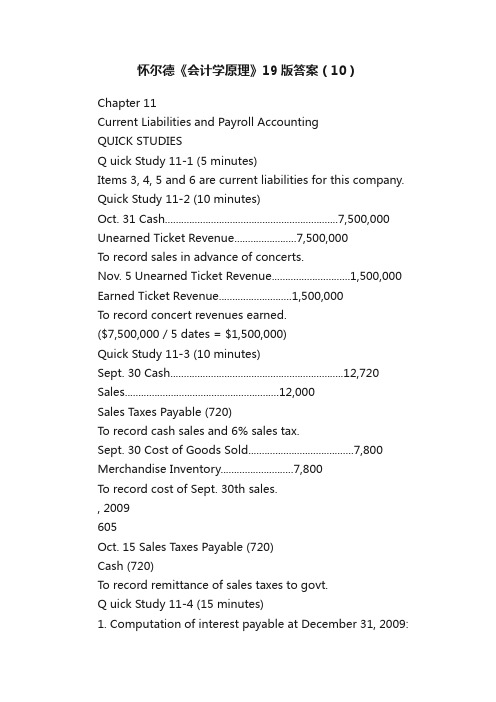
怀尔德《会计学原理》19版答案(10)Chapter 11Current Liabilities and Payroll AccountingQUICK STUDIESQ uick Study 11-1 (5 minutes)Items 3, 4, 5 and 6 are current liabilities for this company. Quick Study 11-2 (10 minutes)Oct. 31 Cash................................................................7,500,000 Unearned Ticket Revenue.......................7,500,000To record sales in advance of concerts.Nov. 5 Unearned Ticket Revenue.............................1,500,000 Earned Ticket Revenue...........................1,500,000To record concert revenues earned.($7,500,000 / 5 dates = $1,500,000)Quick Study 11-3 (10 minutes)Sept. 30 Cash................................................................12,720 Sales.........................................................12,000Sales Taxes Payable (720)To record cash sales and 6% sales tax.Sept. 30 Cost of Goods Sold.......................................7,800 Merchandise Inventory...........................7,800To record cost of Sept. 30th sales., 2009605Oct. 15 Sales Taxes Payable (720)Cash (720)To record remittance of sales taxes to govt.Q uick Study 11-4 (15 minutes)1. Computation of interest payable at December 31, 2009:Days from November 7 to December 31....................54 days Accrued interest (8% x $80,000 x 54/360)..................$9602. 2009Dec.31 Interest Expense (960)Interest Payable (960)To record accrued interest (8% x $80,000 x 54/360).3. 2010Feb. 5 Interest Expense* (640)Payable (960)Interest Payable........................................................80,000Notes Cash................................................................. 81,600To record payment of note plus interest*(8% x $80,000 x 36/360).Quick Study 11-5 (15 minutes)[Note: Two months (January and February) of earnings have already been recorded for each of the 5 employees.] Mar. 31 Payroll Taxes Expense...........................................1,457.50 FICA—Social Security Taxes Payable1........... 930.00 FICA—Medicare Taxes Payable2...................... 217.50State Unemployment Taxes Payable3............. 270.00 Federal Unemployment Taxes Payable4......... 40.00To record employer payroll taxes.1$15,000 x 6.2% = $930.002$15,000 x 1.45% = $217.503[5 x ($7,000 - ($3,000 x 2))] x 5.4% = $270.004[5 x ($7,000 - ($3,000 x 2))] x 0.8% = $40.00Quick Study 11-6 (5 minutes)Vacation Benefits Expense* (250)Vacation Benefits Payable (250)To record vacation benefits accrued.* ($3,250 - $3,000)McG606Quick Study 11-7 (5 minutes)Dec. 31 Employee Bonus Expense....................................15,000 Bonus Payable............................................... 15,000To record expected bonus costs.Q uick Study 11-8 (10 minutes)2009July 24 Estimated Warranty Liability (55)Repair Parts Inventory (55)To record cost of warranty repairs.Quick Study 11-9 (10 minutes)1. (b); reason—is reasonably estimated but not a probable loss.2. (b); reason—probable loss but cannot be reasonably estimated.3. (a); reason—can be reasonably estimated and loss is probable.EXERCISESExercise 11-1 (10 minutes)9. C1. C 3. L 5. C 7. C2. C 4. N 6. L 8. C 10. CE xercise 11-2 (15 minutes)[Note: All entries dated December 31, 2009.]Expense....................................................3,4441. WarrantyEstimated Warranty Liability............................3,444To record warranty expense [4,100 units x 6% x $14].2. No adjusting entry can be made since the loss cannot be reasonablyestimated. Disclosure of the suit as a contingent liability should be made in the notes to the financial statements., 20096073. Vacation Benefits Expense.....................................2,940Vacation Benefits Payable................................2,940To record vacation benefits expense[28 employees x 1 day x $105].4. No adjusting entry is required since it is not probable that the supplier willdefault on the debt. The guarantor, Madison Company, should describe theguarantee in its financial statement notes as a contingent liability.5. Cash...........................................................................556,400Sales.....................................................................520,000Sales Taxes Payable...........................................36,400To record sales and sales taxes.Cost of Goods Sold...................................................260,000Merchandise Inventory.......................................260,000To record cost of sales.Revenue....................................104,0006. UnearnedServicesEarned Services Revenue..................................104,000To record product revenue earned.Exercise 11-3 (15 minutes)1. B = 0.04 ($1,300,000 – B)B = $52,000 – 0.04B1.04B = $52,000$50,000B =2.2009Dec. 31 Employee Bonus Expense................................50,000Bonus Payable...........................................50,000To record expected bonus costs.3.2010Jan. 19 Bonus Payable....................................................50,000Cash............................................................50,000 To record payment of bonus.Exercise 11-4 (30 minutes)1. Maturity date = May 15 + 180 days = November 11, 2009McG608May 15 Cash........................................................................137,000Notes Payable.................................................. 137,000Borrowed cash by issuing an interest-bearing note.2b.Nov 11 Interest Expense*..................................................6,165Payable........................................................137,000NotesCash.................................................................. 143,165Repaid note plus interest.*Principal.....................$137,000x Interest rate................9%x Fraction of year.......... 180/360Total interest.................$ 6,165Exercise 11-5 (30 minutes)1. Maturity date = November 1 + 180 days = April 30, 2010.2. Principal.........................................................................$240,000Interestrate.................................................................10%xx Fraction of year (Nov. 1 – Dec. 31)............................ 60/360Total interest in 2009....................................................$ 4,0003. Principal.........................................................................$240,000rate.................................................................10%xInterestx Fraction of year (Jan. 1 – Apr. 30)............................. 120/360Total interest in 2010....................................................$ 8,0004a.2009Nov. 1 Cash........................................................................240,000Notes Payable.................................................. 240,000Borrowed cash by issuing an interest-bearing note.4b.2009Dec. 31 Interest Expense.................................................... 4,000Interest Payable............................................... 4,000Accrued interest on note payable.McGraw-Hill Companies, 2009 Solutions Manual, Chapter 11 609Apr. 30 Interest Expense....................................................8,000Payable.....................................................4,000InterestPayable........................................................240,000NotesCash.................................................................. 252,000Repaid note plus interest.Exercise 11-6 (20 minutes)Subjectto Tax Rate Tax Explanationa.FICA--Social Security............$2,100 6.20%$130.20Full amount is subject to tax. FICA—Medicare.....................2,100 1.4530.45Full amount is subject to tax. FUTA...........................................1,1000.808.80$1,000 is over the maximum. SUTA...........................................1,100 2.9031.90$1,000 is over the maximum.b. FICA--Social Security............$2,500 6.20%$155.00Full amount is subject to tax. FICA—Medicare.....................2,500 1.4536.25Full amount is subject to tax. FUTA...........................................00.800.00Full amount is over maximum. SUTA...........................................0 2.900.00Full amount is over maximum.c. FICA--Social Security............$6,300 6.20%$390.60$1,100 is over the maximum. FICA—Medicare.....................7,400 1.45107.30Full amount is subject to tax. FUTA...........................................00.800.00Full amount is over maximum. SUTA...........................................0 2.900.00Full amount is over maximum.610E xercise 11-7 (20 minutes)(1)Sept. 30 Salaries Expense...................................................2,100.00 FICA—Social Security Taxes Payable........... 130.20FICA—Medicare Taxes Payable..................... 30.45Employee Federal Income Taxes Payable......250.00Salaries Payable.............................................. 1,689.35To record payroll for pay period ended September 30.(2)Sept. 30 Payroll Taxes Expense..........................................201.35 FICA—Social Security Taxes Payable........... 130.20FICA—Medicare Taxes Payable..................... 30.45Federal Unemployment Taxes Payable......... 8.80State Unemployment Taxes Payable............. 31.90To record employer payroll taxes.Exercise 11-8 (25 minutes)1. Warranty Expense = 3% of dollar sales = 3% x $9,400 = $2822. The December 31, 2009, balance of the liability equals the expensebecause no repairs are provided in 2009. Therefore, the ending balance of the Estimated Warranty Liability account is $282.3. The company should report no additional warranty expense in 2010 forthis copier.4. The December 31, 2010, balance of the Estimated Warranty Liabilityaccount equals the 2010 beginning balance minus the costs incurred in 2010 to repair the copier:Ending 2009 balance..........................................................$ 282Less parts cost (125)Ending 2010 balance..........................................................$ 157McGraw-Hill Companies, 2009 Solutions Manual, Chapter 11 6115. Journal entries2009 (a)Aug. 16 Cash.........................................................................9,400 Sales..................................................................9,400To record cash sale of copier.Aug. 16 Cost of Goods Sold................................................6,500 Merchandise Inventory....................................6,500To record cost of August 16 sale.(b)Dec. 31 Warranty Expense (282)Estimated Warranty Liability (282)To record warranty expense for copier sold in 2009.2010 (c)Nov. 22 Estimated Warranty Liability (125)Repair Parts Inventory (125)To record cost of warranty repairs.McG612PROBLEM SET AProblem 11-1A (45 minutes)Locust Natl. Bank Fargo1. Maturity datesDate of the note........................May 19July 8 Nov. 28Term of the note (in days).......120120 60date.............................Sept. 16Nov. 5 Jan. 27Maturity2. Interest due at maturityPrincipal of the note................$ 39,000$120,000 $60,000Annual interest rate.................9%8.5% 8%year........................ 120/360 120/360 60/360ofFractionexpense.......................$ 1,170$ 3,400 $ 800Interest3. A ccrued interest on Fargo note at the end of 2008Total interest for note.................................................... $ 800Fraction of term in 2008................................................ 33/60Accrued interest expense............................................. $ 4404. Interest on Fargo note in 2009Total interest for note.................................................... $ 800Fraction of term in 2009................................................ 27/60Interest expense in 2009............................................... $ 360McGraw-Hill Companies, 2009 Solutions Manual, Chapter 11 613P roblem 11-1A (Concluded)5.2008Apr. 20 Merchandise Inventory........................................48,250Accounts Payable—Locust........................... 48,250Purchased merchandise on credit.May 19 Accounts Payable—Locust.................................48,250Cash................................................................. 9,250Notes Payable—Locust.................................. 39,000Paid $9,250 cash and gave a 120-day,9% note to extend due date on account.July 8 Cash.......................................................................120,000 Notes Payable—National............................... 120,000 Borrowed cash with a 120-day, 8.5% note.Sept. 16 Interest Expense...................................................1,170 Payable—Locust........................................39,000Notes Cash................................................................. 40,170Paid note with interest.Nov. 5 Interest Expense...................................................3,400 Payable—National.....................................120,000Notes Cash................................................................. 123,400Paid note with interest.28 Cash.......................................................................60,000 Notes Payable—Fargo Bank.......................... 60,000 Borrowed cash with 60-day, 8% note.Dec. 31 Interest Expense (440)Interest Payable (440)Accrued interest on note payable.2009Jan. 27 Interest Expense (360)Notes Payable—Fargo Bank................................60,000 (440)InterestPayable Cash................................................................. 60,800Paid note with interest.McGraw-Hill Companies, 2009Fundamental Accounting Principles, 19th Edition 6141.2008Nov. 11 Cash..........................................................................4,500 Sales...................................................................4,500Sold razors to customers.11 Cost of Goods Sold.................................................1,200Merchandise Inventory.....................................1,200To record cost of November 11 sale (75 x $16).30 Warranty Expense (315)Estimated Warranty Liability (315)To record razor warranty expenseand liability at 7% of selling price.Dec. 9 Estimated Warranty Liability (240)Merchandise Inventory (240)To record cost of razor warrantyreplacements (15 x $16).16 Cash..........................................................................12,600Sales...................................................................12,600Sold razors to customers.16 Cost of Goods Sold.................................................3,360Merchandise Inventory.....................................3,360To record cost of December 16 sale (210 x $16).29 Estimated Warranty Liability (480)Merchandise Inventory (480)To record cost of razor warrantyreplacements (30 x $16).31 Warranty Expense (882)Estimated Warranty Liability (882)To record razor warranty expenseand liability at 7% of selling price., 20096152009Jan. 5 Cash..........................................................................7,800Sales...................................................................7,800Sold razors to customers.5 Cost of Goods Sold.................................................2,080Merchandise Inventory.....................................2,080To record cost of January 5 sale (130 x $16).17 Estimated Warranty Liability (560)Merchandise Inventory (560)To record cost of razor warrantyreplacements (35 x $16).31 Warranty Expense (546)Estimated Warranty Liability (546)To record razor warranty expenseand liability at 7% of selling price.2. Warranty expense for November 2008 and December 2008Sales Percent Warranty Expense November.................$ 4,500 7%$ 315December.................. 12,6007 882Total..........................$17,100$1,197expense for January 20093. WarrantySales in January...........................$ 7,800Warranty percent.......................... 7%Warranty expense........................$ 5464. Balance of the estimated liability as of December 31, 2008Warranty expense for November...................................$ 315creditWarranty expense for December...................................882 credit Cost of replacing items in December (45 x $16).......... (720)debitEstimated Warranty Liability balance............................$ 477 credit5. Balance of the estimated liability as of January 31, 2009Beginning balance.......................................................... $ 477 credit credit Warranty expense for January (546)Cost of replacing items in January (35 x $16).............. (560)debitEstimated Warranty Liability balance........................... $ 463 creditMcG6161. Each employee’s FICA withholdings for Social SecurityDahlia Trey Kiesha Chee Total Maximum base.............$102,000$102,000$102,000$102,000Earned through 8/18.... 100,500 31,850 6,260 1,000W ould-be subject to tax..$ 1,500$ 70,150$ 95,740$101,000 Earned this week.......... $ 3,600$ 1,275$ 1,440 $ 400Pay subject to tax......... 1,5001,2751,440 400Tax rate......................... 6.20% 6.20% 6.20% 6.20%Social Security tax....... $ 93.00$ 79.05$ 89.28 $ 24.80 $286.132. Each employee’s FICA withholdings for Medicare (no limits)Dahlia Trey Kiesha Chee Total Earned this week..........$ 3,600$ 1,275$ 1,440$ 400Tax rate......................... 1.45% 1.45% 1.45% 1.45% Medicare tax.................$ 52.20$ 18.49$ 20.88$ 5.80$ 97.373. Employer’s FICA taxes for Social SecurityDahlia Trey Kiesha Chee Total Amount from part 1......$ 93.00$ 79.05$ 89.28$ 24.80$286.134. Employer’s FICA taxes for MedicareDahlia Trey Kiesha Chee Total Amount from part 2......$ 52.20$ 18.49$ 20.88$ 5.80$ 97.37, 2009617P roblem 11-4A (Concluded)5. Employer’s FUTA taxesDahlia Trey Kiesha Chee Total Maximum base..............$ 7,000$ 7,000$ 7,000$ 7,000Earned through 8/18..... 100,500 31,850 6,260 1,000W ould-be subject to tax...007406,000Earned this week.........$ 3,600$ 1,275$ 1,440$ 400Pay subject to tax (00740400)Tax rate........................ 0.8% 0.8% 0.8% 0.8%FUTA tax......................$ 0.00$ 0.00$ 5.92$ 3.20 $ 9.12 6. Employer’s SUTA taxesDahlia Trey Kiesha Chee T otal Subject to tax (from 5)$ 0$ 0$ 740$ 400Tax rate........................ 2.15% 2.15% 2.15% 2.15%SUTA tax......................$ 0.00$ 0.00$ 15.91$ 8.60 $ 24.51 7. Each employee’s net (take-home) payDahlia Trey Kiesha Chee Total Gross earnings.............$3,600.00 $1,275.00$1,440.00$400.00$6,715.00 LessFICA Social Sec. tax....(93.00)(79.05)(89.28)(24.80)(286.13) FICA Medicare taxes.... (52.20)(18.49)(20.88) (5.80)(97.37) Withholding taxes........ (450.00)(140.00)(173.00) (36.00)(799.00) Health insurance.......... (11.00) (11.00) (11.00) (11.00) (44.00) Take-home pay............. $2,993.80$1,026.46$1,145.84 $322.40$5,488.50 8. Employer’s total payroll-related expense for each employeeDahlia Trey Kiesha Chee T otal Gross earnings..............$3,600.00 $1,275.00$1,440.00$400.00$6,715.00 PlusFICA Social Sec. tax......93.0079.0589.2824.80286.13 FICA Medicare taxes.....52.2018.4920.88 5.80 97.37 FUTA tax.........................0.000.00 5.92 3.20 9.12 SUTA tax.........................0.000.0015.91 8.60 24.51 Health insurance............11.0011.0011.00 11.00 44.00 Pension contrib. (8%).... 288.00 102.00 115.20 32.00 537.20 Total payroll expense....$4,044.20$1,485.54$1,698.19 $485.40 $7,713.33?McG 618Problem 11-4A (25 minutes)Part 1Jan. 8 Office Salaries Expense...................................27,760Sales Salaries Expense....................................70,240FICA—Social Sec. T axes Payable*........... 6,076FICA—Medicare Taxes Payable**............. 1,421Employee Fed. Inc. Taxes Payable........... 13,360Employee Medical Insurance Payable...... 1,350Employee Union Dues Payable (840)Salaries Payable......................................... 74,953To record payroll for period.* $98,000 x 6.2%** $98,000 x 1.45%P art 2Jan. 8 Payroll Taxes Expense.....................................13,181FICA—Social Sec. T axes Payable............. 6,076FICA—Medicare Taxes Payable................ 1,421State Unemployment Taxes Payable*....... 4,900F ederal Unemployment Taxes Payable** (784)To record employer payroll taxes.* $98,000 x .05 = $4,900**$98,000 x .008 = $784McGraw-Hill Companies, 2009 Solutions Manual, Chapter 11 619。
会计学原理 怀尔德
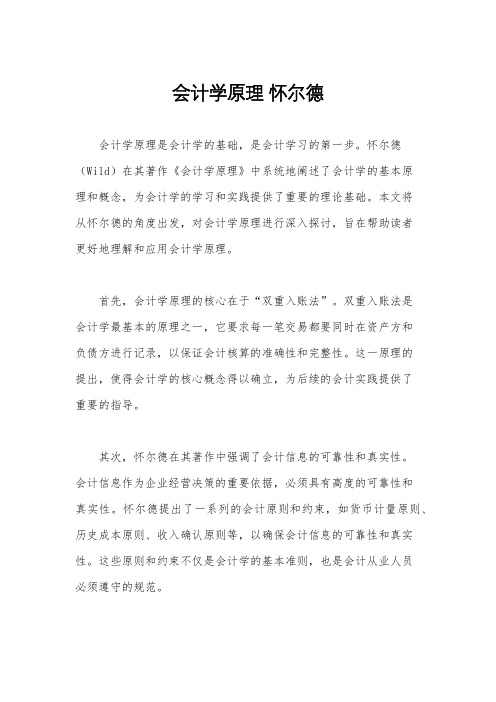
会计学原理怀尔德会计学原理是会计学的基础,是会计学习的第一步。
怀尔德(Wild)在其著作《会计学原理》中系统地阐述了会计学的基本原理和概念,为会计学的学习和实践提供了重要的理论基础。
本文将从怀尔德的角度出发,对会计学原理进行深入探讨,旨在帮助读者更好地理解和应用会计学原理。
首先,会计学原理的核心在于“双重入账法”。
双重入账法是会计学最基本的原理之一,它要求每一笔交易都要同时在资产方和负债方进行记录,以保证会计核算的准确性和完整性。
这一原理的提出,使得会计学的核心概念得以确立,为后续的会计实践提供了重要的指导。
其次,怀尔德在其著作中强调了会计信息的可靠性和真实性。
会计信息作为企业经营决策的重要依据,必须具有高度的可靠性和真实性。
怀尔德提出了一系列的会计原则和约束,如货币计量原则、历史成本原则、收入确认原则等,以确保会计信息的可靠性和真实性。
这些原则和约束不仅是会计学的基本准则,也是会计从业人员必须遵守的规范。
另外,怀尔德还对会计学的伦理要求进行了深入的探讨。
他指出,会计从业人员应当秉持诚实、公正、勤勉的职业道德,不得隐瞒真相,不得篡改账簿,不得为企业谋取私利。
这些伦理要求不仅是会计从业人员的职业操守,也是企业经营的基本原则,是维护市场秩序和保障投资者利益的重要保障。
最后,怀尔德在其著作中还强调了会计学的系统性和科学性。
会计学作为一门独立的学科,应当具有系统的理论框架和科学的研究方法。
怀尔德提出了会计学的基本概念和分类体系,为会计学的发展奠定了坚实的理论基础。
同时,他还倡导了会计学的实证研究和理论创新,为会计学的发展注入了新的活力。
总之,怀尔德的《会计学原理》是会计学的经典著作,对会计学的发展产生了深远的影响。
其强调的双重入账法、会计信息的可靠性和真实性、会计伦理要求以及会计学的系统性和科学性,为会计学的学习和实践提供了重要的指导。
我们应当深入学习和理解怀尔德的思想,不断提高自身的会计素养,为企业的健康发展和社会的经济进步贡献自己的力量。
2019会计原理基础复习要点共32页word资料

会会一、资产类一、现金1、备用金a、发生时:借:其他应收款-备用金(或直接设备用金科目)贷:库存现金b、报销时:借:管理费用(等费用科目)贷:库存现金定额:先核定备用金定额并拨付备用金,职工报销时据实报销,不冲减“其他应收款——备用金”借其他应收款——备用金 1000贷库存现金 1000借管理费用 800贷库存现金 800(2)非定额:不核定备用金可根据情况拨付备用金,职工报销时冲减“其他应收款——备用金”。
借其他应收款——备用金 1500贷库存现金 1500借管理费用 800库存现金 700(退回现金)贷其他应收款——备用金 15002、现金清查a、盈余借:库存现金贷:待处理财产损溢-待处理流动资产损益查明原因:借:待处理财产损溢-待处理流动资产损益贷:营业外收入(无法查明)其它应付款一应付X单位或个人b、短缺借:待处理财产损溢-待处理流动资产损益贷:库存现金查明原因:借:管理费用(无法查明)其他应收款-应收现金短缺款(个人承担责任)其他应收款-应收保险公司赔款贷:待处理财产损溢-待处理流动资产损益3、接受捐赠借:库存现金贷:待转资产价值-接收货币性资产价值缴纳所得税借:待转资产价值-接收货币性资产价值贷:资本公积-其他资本公积应交税金-应交所得税二、银行存款A、货款交存银行借:银行存款贷:库存现金B、提取现金借:库存现金贷:银行存款三、其他货币资金A、取得:借:其他货币资金-外埠存款(等)贷:银行存款B、购买原材料:借:原材料应交税金-应交增值税(进项税)贷:其他货币资金-(明细)C、取得投资:借:短期投资贷:其他货币资金-(明细)四、应收票据A、收到银行承兑票据借:应收票据贷:应收账款B、带息商业汇票计息借:应收票据贷:财务费用(一般在中期末和年末计息)C、申请贴现借:银行存款财务费用(=贴现息-本期计提票据利息)贷:应收票据(帐面数)D、已贴现票据到期承兑人拒付(1)银行划付贴现人银行帐户资金借:应收账款-X公司贷:银行存款(2)公司银行帐户资金不足借:应收账款-X公司贷:银行存款短期借款(帐户资金不足部分)E、到期托收入帐借:银行存款贷:应收票据F、承兑人到期拒付借:应收账款(可计提坏账准备)贷:应收票据G、转让、背书票据(购原料)借:原材料(在途物资)应交税金-应交增值税(进项税)贷:应收票据五、应收账款A、发生:借:应收账款-X公司(扣除商业折扣额)贷:主营业务收入应交税金-应交增值税(销项税)B、发生现金折扣:借:银行存款(入帐总价-现金折扣)财务费用贷:应收账款-X公司(总价)C、发生销售折让:借:主营业务收入应交税金-应交增值税(销项税)贷:应收账款D、计提坏账准备(备抵法)借:管理费用-坏帐损失贷:坏账准备注:如计提前有借方余额,应提数=借方余额+本期应提数;如计提前有贷方余额,应提数=本期应提数-贷方余额(负数为帐面多冲减管理费用)。
- 1、下载文档前请自行甄别文档内容的完整性,平台不提供额外的编辑、内容补充、找答案等附加服务。
- 2、"仅部分预览"的文档,不可在线预览部分如存在完整性等问题,可反馈申请退款(可完整预览的文档不适用该条件!)。
- 3、如文档侵犯您的权益,请联系客服反馈,我们会尽快为您处理(人工客服工作时间:9:00-18:30)。
Accounting Equation
Assets = Liabilities + Equity Be proficient in 11 transactions from P11~13 Be proficient in 3 statements Income statement, Statement of Owner’s Equity & Balance Sheet
Accounting Байду номын сангаасrocess
1. 2. 3. 4. 5. 6. 7. Source documents Journal Ledger Adjusting Adjusted trial balance Statements Closing
Adjusting
*Depreciation
Dr. Depreciation Expenses; Cr. Accumulated Depreciation Accumulated Depreciation is a contra account
e-mail me if necessary samj525@ 1/2
Principles of Accounting 19 Edition
th
Sam.J @ NJAudit
Chapter 2 Analyzing and Recording Transactions Chapter 3 Adjusting Accounts and Preparing Financial Statements Chatper 4 Completing the Accounting Cycle
e-mail me if necessary samj525@ 2/2
Four assumptions
Going concern Monetary unit Time period Business entity
Four principles
Cost Matching Revenue recognition Full disclosure
Business entity
Principles of Accounting 19 Edition
th
Sam.J @ NJAudit
Chapter 1 Accounting in Business
Users of Acc. Information
External users: creditors & investors Internal users Know the difference between FINICIAL ACCOUNTING & MANAGERIAL ACCOUNTING
Closing
Close Temporary account: Revenue, Expenses, Owner Withdrawals & Income Sumary Step1: Dr. Revenue ; Cr. Income Summary Step2: Dr. Income Summary ; Cr. Expenses Step3: Dr. Income Summary ; Cr. Owner’s Capital Step4: Dr. Owner’s Capital ; Cr. Owner’s Withdrawls
Generally Accepted Accounting Principles Know what is:
GAAP (Generally Accepted Accounting Principles) FASB (Financial Accounting Standards Board) SEC (Securities and Exchange Commission) IASB (International Accounting Standards Board) IFRS (International Financial Reporting Standards)
